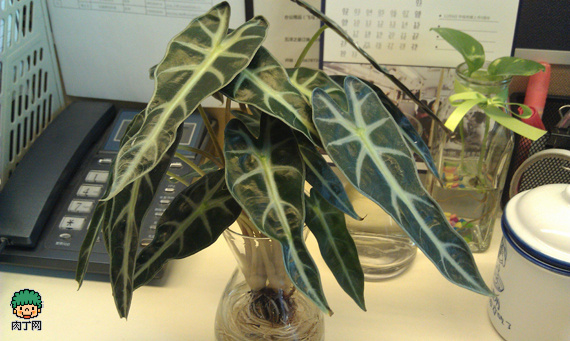观音莲,又称黑叶芋、龟甲芋、黑叶观音莲,为天南星科海芋属观叶植物,原生于亚洲热带,多年生草本植物,地下部分具肉质块茎,并容易分蘖形成丛生植物,叶为箭形盾状,花为佛焰花序,从茎端抽生,喜温湿润、半阴的生长环境。
天南星科的观音莲为多年生草本植物,地上茎有时高达2—3米,全株最高可达5米。
观音莲喜半阴、温暖、湿润和半阴环境。切忌强光暴晒。在半阴环境下,叶色鲜嫩而富有光泽,叶脉清晰,叶色深绿。
切忌强光暴晒。容易使叶色暗淡,甚至产生日灼,叶面粗糙,叶色灰白,叶脉模糊,叶面有时发生灼伤斑点;
但光线太弱也易引起徒长 ,植株生长纤细而易倒伏。在生长旺盛期可根据植株生长情况,每月施1-2次稀薄液肥,并增施磷钾肥,以利植株茎干直立,生长健壮,同时有利于地一块茎生长充实及冬季抗寒越冬。

生长适温25~30℃,冬季温度不低于15℃。3~9月为22~27℃,9月至翌年3月为16~22℃。气温低于15℃,生长停滞呈休眠状态。其中大叶观音莲耐寒力较强,可耐1℃以下低温,但不能低于-7℃。 黑叶观音莲耐水湿,生长季节盆土要保持湿润,空气湿度在70%~80%,有利叶片生长发育。黑叶观音莲在盆土干旱情况下,叶片柔软下垂,但浇水后很快恢复原状,对干旱也有一定抗性。
土壤以排水好、肥沃、疏松的腐叶土或泥炭土为合适。
观音莲的繁殖方法主要包括分株繁殖、组培苗繁殖、叶插繁殖、插穗繁殖、播种法繁殖等方法。
播种繁殖法 在观音莲的开花成熟时候后采集到观音莲的种子,然后将种子在适宜的温暖的温度条件下发芽,长出幼苗,待幼苗稍加成长就可以移栽了。(这点大家可以忽略不计,虽然可用播种繁殖,但种子不易得到。)
组培苗繁殖 就是将观音莲叶子和块茎等作为幼种,将叶子切小块进行整组的接种,先用无菌水进行消毒;再用营养液进行培养幼种直至生芽可以成为幼苗进行移栽。
叶插繁殖 就是选择观音莲中生长网申的一个叶片平放在营养土里,一段时期后原来那个叶片就会长出新的小叶芽和根部,取它的根部移栽在土里进行正常的培育,直到长成一株新的观音莲。
观音莲最常用分株繁殖 一般于每年春夏气温较高时,将地下块茎分蘖生长茂密的植株沿块茎分离处分割,使每一部分具有2-3株,然后分别上盆种植。分株时尽量少伤根,同时上盆后宜置于阴湿环境,保持盆土经常湿润,并注意叶面喷雾,以利新植株恢复生长。也可于春季新芽抽长前将地下块茎挖出,将块茎切段分离,用草木灰或硫黄粉对伤口进行消毒防腐,稍晾干后用水苔包扎,或置于通气排水的疏松土壤中,使其长出不定根,抽长新芽。(此间切忌基质过湿,以免块茎腐烂。
土:腐叶土或泥炭土为合适。
水:喜水
肥:大水大肥(因为黑叶芋种植要求土壤排水好,所以肥的用量不必太小,否则植株徒长,容易倒伏)。
阳光:黑叶芋喜阴,别看他叶子大,但是却是不折不扣的喜阴植物。
气温:上面有讲,这里再重复一遍,生长适温25~30℃,冬季温度不低于15℃。3~9月为22~27℃,9月至翌年3月为16~22℃。气温低于15℃,生长停滞呈休眠状态。
湿度:喜湿,如果室内过于干燥的话黑叶芋的叶子长的就会不那么好看,因为我们多半都是在家或者工作的地方养,家里不能太湿,公司你又控制不了,那么你就需要一个喷壶,经常的给i叶子喷水,这样也是想要在室内将养黑叶芋养好的办法。
Originating in tropical Southeast Asia, this popular elephant’s ear (Alocasia amazonica, part of the Alocasia genus) is a striking and beautiful houseplant, with deep green leaves accentuated by whitish or light green leaf veins. It’s a hybrid that has become a fairly popular ornamental house plant and is one of the easiest to find and buy. The leaves are roughly serrated, and in some cases, the leaf color appears as an almost purple green.
They are fleshy, truly tropical plants that grow from underground corms. It is a flowering houseplant that typically grows as an evergreen, which is defined as a plant that retains leaves throughout the year.
Please take caution!! This is one of the many poisonous houseplants you may have in your home, so keep away from children and pets that may eat or bite at the plant.
Growing Conditions
Here are tips on growing the Amazon elephant’s ear:
- Light: Bright, indirect light. They can survive in 80 percent shade but prefer about 60 percent shade. Do not expose to strong, direct sunlight.
- Water: Like most alocasias, the Amazon elephant’s ear likes wet feet. Keep the potting media moist at all times. A rest period should be allowed in winter by allowing the soil to become almost dry between waterings and stop fertilizing. If it dries completely it may go dormant, however, it will recuperate in a month or two, with good care.
- Temperature: This is a tropical plant that will go dormant or die if exposed to cold. Do not let temperature remain under 50º Fahrenheit. If the plant does go dormant, you may be able to dig up the corm and save it until warmer conditions are possible.
- Humidity: These plants like slightly higher humidity levels than many other plants. You may need to raise the humidity levels in a room artificially by placing the plant in a humidity tray with pebbles or use a humidifier.
- Soil: These plants like a fast-draining, well-aerated potting soil.
- Fertilizer: Feed with a diluted balanced fertilizer from spring every 2 weeks and stop at the end of August then start again at the beginning of spring.
Propagation
Amazon elephant’s ears are best propagated by division during repotting. In a very healthy specimen with multiple stems, corms can be dug up from the existing pot and repotted into smaller pots.
Repotting
A well-grown plant may need yearly repotting. Keep in mind, however, that these plants like to be slightly underpotted for best foliage development.
Growing Tips
Overall the Elephant’s Ear is usually not prone to pests, but if they should appear, spray the plant with a soapy water mixture twice a day.
These are excellent houseplants. Amazon elephant ears are striking, and their dramatic two-tone leaf coloration is unique. However, they are truly tropical plants, which means they appreciate lots of warmth, humidity, and water. A large specimen may grow up to 3 feet, but most are smaller. Cut away dead and dying leaves for the best presentation, and keep an eye out for mites.